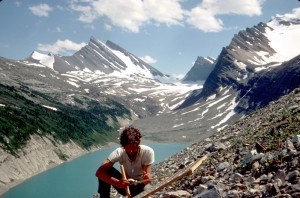
Western University professor Brian Luckman and his students have spent the last 40 years studying glaciers in the Rocky Mountains and the effects climate change has had on its rapidly transforming landscapes. Now Jasperites have a chance to scratch the surface of their research through a new exhibit at the Jasper Yellowhead Museum and Archives.
“Locals will learn something new and exciting about their backyard while tourists will get an idea behind what they are seeing as they tour the park,” said the museum’s exhibit designer and coordinator Carla Slover. “I’ve been here 20 years and I learned something new through this exhibit.”
Luckman originally studied glaciers in England, but moved to Canada in the 1960s and quickly selected Jasper National Park as the place where he would dedicate most of his life’s work. The museum’s exhibit showcases just a sliver of the extensive research Luckman has carried out on Mount Edith Cavell and the Athabasca Glacier. Along with studying the gigantic ice formations, Luckman’s work also takes an in depth look at the trees and logs in the area, which have helped Luckman determine what the climate was like in the region thousands of years ago.
“Most people who come to the park can’t read the landscape. They look at the glaciers like a lump of ice,” Luckman said. “It’s important to give people some information on how glaciers behave so that they have a better appreciation in the value of preserving that landscape and understanding it.”
During the past few decades, warmer temperatures have changed a lot of things throughout the park said Luckman, however, the most significant change he’s noticed is the shrinking landscape of the park’s glaciers.
Using photos, Luckman’s exhibit documents the Athabasca Glacier as it melts and recedes from Highway 93 and the separation of Mount Edith’s two glaciers; Cavell and Angel.
“The glaciers are losing about one per cent of their area per year. It’s likely in 100 years they won’t exist if they continue to recede at the present rate,” Luckman said. “Possibly in 50 years we might not be able to see the Athabasca Glacier from the highway.”
In terms of what can be done to slow down this process, Luckman said he believes it’s too late—that the damage is already done.
“Having been working in that field for decades I know that things haven’t changed a great deal,” Luckman said. “My view is rather pessimistic. I think the trends that we are seeing are going to continue and my grandchildren will have to deal with the effects.”
However, in order for future generations to help cope with the damage of climate change Luckman said that it’s important for today’s youth to immerse themselves in the region’s environmental history.
“The best way to actually appreciate future climate change is to understand how climates have changed in the past,” Luckman said.
Luckman’s exhibit also features regional tree cookies and log wedges which date back more than 6,000 years ago and three Parks Canada videos showcasing some of Luckman’s work at Mount Edith Cavell and the Columbia Icefield.
Luckman’s exhibit will be on display at the Jasper Yellowhead Museum and Archives until Oct. 31.
Kayla Byrne [email protected]
